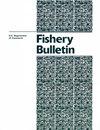Validation of methods for aging goosefish (Lophius americanus) based on length-mode progression of a strong cohort
IF 0.8
4区 农林科学
Q3 FISHERIES
引用次数: 1
Abstract
Northeast Fisheries Science Center National Marine Fisheries Service, NOAA 166 Water Street Woods Hole, Massachusetts 02543 Abstract—An unusually strong year class of goosefish (Lophius americanus) was first observed in the spring of 2015, and the length mode for this particular cohort remained evident for several years. We collected monthly samples from within this length mode over a period of 3 years and considered them fish with known ages for validating ages estimated by using illicia and vertebrae. Recent research had found vertebral ages for goosefish to be inaccurate, and a method in which illicia are used for Lophius species in Europe seemed promising. However, ring counts from illicia matched the known age only 50% of the time and were not replicable (9% agreement). Ring counts from vertebrae never matched the known age but were replicable in 68% of samples. Marginal increment analysis of illicia from fish that matched the known age provided evidence that one annulus is formed on the illicium in spring or summer of each year for fish aged from 1 to 2 years. Because of the low accuracy of age estimates made with both illicia and vertebrae, as well as the high bias of aging with vertebrae, we concluded that the methods based on these structures did not provide useful age estimates of goosefish. The observed growth rate, based on the progression of the length mode during our study, was much faster than the growth rates based on vertebral ages.基于强队列的长度模式进展验证老化鹅鱼(美洲鹅鱼)的方法
摘要:2015年春天,科学家首次观察到一群异常强壮的美洲鹅鱼(Lophius americanus),这群鹅鱼的长度模式在几年里一直很明显。在3年的时间里,我们每月从这种长度模式中收集样本,并将它们视为已知年龄的鱼,以验证通过伊利亚和椎骨估计的年龄。最近的研究发现,对鹅鱼的脊椎年龄是不准确的,而一种将伊利西亚用于欧洲罗菲斯物种的方法似乎很有希望。然而,来自伊利西亚的戒指计数只有50%的时间与已知的年龄相符,并且不可复制(9%一致)。椎骨的环计数与已知的年龄不匹配,但在68%的样本中是可复制的。对与已知年龄相匹配的鱼的illicum进行边际增量分析,证明1 ~ 2岁鱼的illicum在每年的春季或夏季形成一个环。由于用髂骨和椎骨进行年龄估计的准确性较低,以及用椎骨进行衰老的高偏差,我们得出结论,基于这些结构的方法不能提供有用的鹅鱼年龄估计。在我们的研究中,基于长度模式的进展所观察到的生长速度比基于椎体年龄的生长速度要快得多。
本文章由计算机程序翻译,如有差异,请以英文原文为准。
求助全文
约1分钟内获得全文
求助全文
来源期刊

Fishery Bulletin
农林科学-渔业
CiteScore
1.70
自引率
12.50%
发文量
76
审稿时长
>24 weeks
期刊介绍:
The quarterly Fishery Bulletin is one of the oldest and most respected fisheries journals in the world. It has been an official publication of the U.S. Government since 1881, under various titles, and is the U.S. counterpart to other highly regarded governmental fisheries science publications. It publishes original research and interpretative articles in all scientific fields that bear on marine fisheries and marine mammal science.
 求助内容:
求助内容: 应助结果提醒方式:
应助结果提醒方式:


